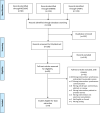Electronic consultation in correctional facilities worldwide: a scoping review
- PMID: 35922103
- PMCID: PMC9352998
- DOI: 10.1136/bmjopen-2021-055049
Electronic consultation in correctional facilities worldwide: a scoping review
Abstract
Objective: To provide an overview of the use of and evidence for eConsult in correctional facilities worldwide.
Design: Scoping review.
Data sources: Three academic databases (MEDLINE, Embase and CINAHL) were searched to identify papers published between 1990 and 2020 that presented data on eConsult use in correctional facilities. The grey literature was also searched for any resources that discussed eConsult use in correctional facilities. Articles and resources were excluded if they discussed synchronous, patient-to-provider or unsecure communication. The reference lists of included articles were also hand searched.
Results: Of the 226 records retrieved from the academic literature search and 595 from the grey literature search, 22 were included in the review. Most study populations included adult male offenders in a variety of correctional environments. These resources identified 13 unique eConsult services in six countries. Six of these services involved multiple medical specialties, while the remaining services were single specialty. The available evidence was organised into five identified themes: feasibility, cost-effectiveness, access to care, provider satisfaction and clinical impact.
Conclusions: This study identified evidence that the use of eConsult in correctional facilities is beneficial and avoids unnecessary transportation of offenders outside of the facilities. It is feasible, cost-effective, increases access to care, has an impact on clinical care and has high provider satisfaction. Some gaps in the literature remain, and we suggest further research on patient satisfaction, enablers and barriers to implementation, and women, youth and transgender populations in this setting to inform service providers and stakeholders. Despite some gaps, eConsult is evidently an important tool to provide timely, high-quality care to offenders.
Keywords: INTERNAL MEDICINE; PRIMARY CARE; Quality in health care; Telemedicine.
© Author(s) (or their employer(s)) 2022. Re-use permitted under CC BY-NC. No commercial re-use. See rights and permissions. Published by BMJ.
Conflict of interest statement
Competing interests: CL and EK are co-executive directors of the Ontario eConsult Centre of Excellence, funded by the Ontario Ministry of Health. They cofounded the Champlain BASE (Building Access to Specialists through eConsultation) eConsult service but do not retain any proprietary rights. EK answers eConsults through the service, less than one per month.
Figures



References
-
- Teichert E. Putting telemedicine behind bars. Mod Healthc 2016;46:2. - PubMed
-
- Maruschak LM, Berzofsky M, Unangst J. Medical problems of state and federal prisoners and jail inmates, 2011-12. U.S. department of justice, 2015. Available: https://bjs.ojp.gov/content/pub/pdf/mpsfpji1112.pdf [Accessed 13 Aug 2020].
Publication types
MeSH terms
LinkOut - more resources
Full Text Sources
